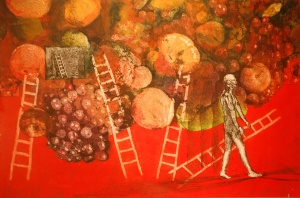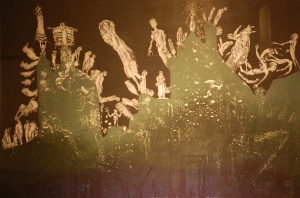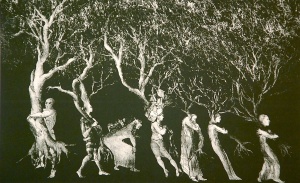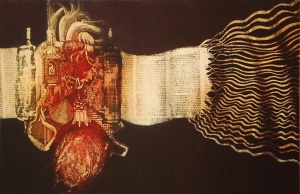Kupferminc’s Wanderings
Mirta Kupferminc is an artist who has made her artistic mission a search for meaning in a world profoundly unstable, problematic and filled with the terrors of memory not entirely her own. As the child of Holocaust survivors, uprooted from Europe and planted in Argentina, one prevailing motif for her is that of a witness to the Holocaust one generation removed. A prominent text panel quotes Saul Sosnowski: “…to be a witness who loves unconditionally; daring to judge God over Auschwitz and find him guilty; and pray to him still, even there, even in Auschwitz.”
Under the watchful guidance of director Jean Bloch Rosensaft and the curatorial skill of Laura Kruger the Hebrew Union College Museum presents Wanderings: Works by Mirta Kupferminc delving into the artist’s exploration of the quest for Divine knowledge, the Holocaust, and the mysteries of memory.
Kupferminc is an extremely accomplished graphic artist, sculptor and book artist producing limited edition books utilizing texts from Saul Sosnowski, Eliahu Toker and Santiago Kavadloff. Her book titles include Exodus, Sepharad, Forgotten Memories, Jewish Highlights and.Borges and the Kabbalah: Paths to the Word

From Borges and the Kabbalah we see the particularly intriguing Four Who Entered the Garden. Referencing the famous passage in Hagigah 14b; “Four men entered the ‘Garden,’ namely, Ben Azzai and Ben Zoma, Aher, and R. Akiva…. Ben Azzai cast a look and died… Ben Zoma looked and became demented… Aher (Elisha b. Abuyah) mutilated the shoots (became an apostate).” Even as countless commentaries have plumbed the hidden meanings of this passage Kupferminc harnesses the visual metaphor of the ladder to sharpen our understanding. Four ladders are poised to access the fruits, literally, of a supernal paradise. And yet much is amiss; one ladder has fallen, Ben Azzai’s fate, the other ladders are ensnared and deeply compromised by madness and apostasy and a fifth ladder is glimpsed inside the garden itself indicating that even with spiritual insight there is more beyond. A sole figure is exiting, Rabbi Akiva who emerged unscathed, and yet we can see graphic echoes of his three companions behind him. In our quest for the Divine, successful or not, we are all fellow travelers.

Many of Kupferminc’s etchings are populated by hordes of little people trudging along the edges of clear-cut shapes, some amorphic, some human, all mysterious. In Ghosts at the Lodz Ghetto the figures create an entire universe of Jewish life; children, workers, old men and young, madmen and holy men, all stamped with the compulsory Star of David badge, all memories of the countless victims of terror.

Another kind of terror is evoked in the haunting etching On the Way. Here the initially puzzling image of a march of people, each carrying an uprooted tree yields a painful insight to the condition of exile. This very uprootedness is a burden exiles must bear even when they find a home. This condition marks and defines a consciousness that unifies each exile with another, much like the upper branches of the six trees that come together to form one organic whole. Considering the history of the artist and her parents; Hungarian Jews who survived Auschwitz, exiles from their homeland, first to Italy and finally to Argentina where she grew up as a Argentinian haunted by the disappearances of political dissidents, ordinary citizens and many Jews, this work is deeply personal.

Kupferminc’s facility at creating images that encapsulate complex concepts is further demonstrated in Thirty-Two are the Paths, an etching that references the 32 Paths of Wisdom found in the ancient mystical Sefer Yitzirah. In her image we see a Sefer Torah open and impossibly unrolling in both directions. The central panels between the Etz Chaim are obscured by mysterious objects, suggesting a human heart with its blood vessels engaged in the mundane world. As the Torah text unrolls to the right its margin begins to split into 32 separate strands, a powerful assertion that all wisdom and all secrets to access the Divine are to be found in the Torah itself.
Mirta Kupferminc is a complex artist tackling some of the most vexing questions facing Jews today. The quest for the Divine, to draw close and attempt to achieve understanding is fraught with fear and trepidation. God is a burning fire and still a constant temptation. He is our obsession. And yet we cannot forget the Holocaust itself, how it has profoundly dislocated us in both our relationship with our God we incessantly seek and our essential uprootedness whether we are in the Diaspora and even in our precious Land of Israel. Staring into the abyss these are the subjects Kupferminc faces. She does not blink even as we must.
Hebrew Union Collage Museum
One West 4th Street, New York, NY
www.huc.edu/museums/ny